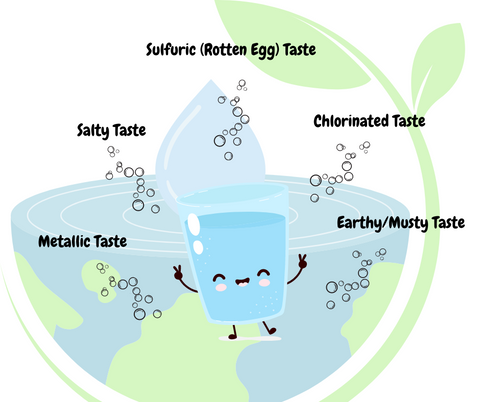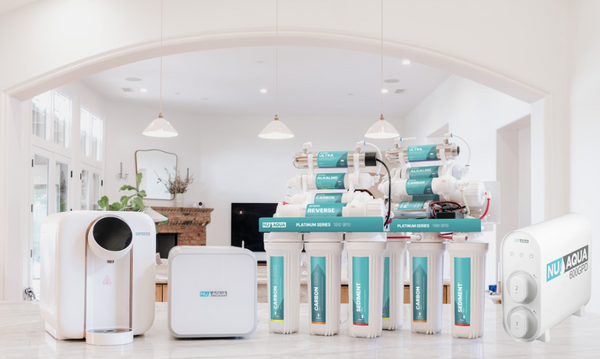Water's taste varies due to differences in source, treatment, and distribution. These taste variations can reveal information about the water's quality and what it contains.
Common Types of Drinking Water Tastes
Drinking water can have a variety of tastes, each influenced by different elements and compounds. Here are some of the most common taste profiles:
-
Metallic Taste: This is often due to the presence of metals like iron, zinc, or manganese in the water. These can come from plumbing, water source, or even the breakdown of old pipes. A metallic taste can also indicate the water’s high mineral content, especially in areas with heavy industrial activity or mining.
-
Salty Taste: Water that tastes salty may have high levels of sodium or other dissolved salts. This taste is commonly associated with water from private wells or coastal regions where seawater intrusion is a problem. It can also result from the presence of chloride ions in the water supply.
-
Sulfuric (Rotten Egg) Taste: A sulfuric or rotten egg taste in water is often due to hydrogen sulfide gas. This can occur naturally from decaying organic matter in groundwater or from certain types of bacteria in water systems. It's not only unpleasant but can also indicate the need for water system maintenance.
-
Chlorinated Taste: Water treated with chlorine to kill bacteria and other pathogens can have a noticeable chlorinated taste. While chlorine is essential for preventing waterborne diseases, too much can lead to a strong, pool-like flavor that many find unappealing.
-
Earthy/Musty Taste: This taste can come from natural organic compounds in water, such as those produced by decaying vegetation or certain algae. While generally harmless, it can affect the palatability of drinking water and may indicate the need for filtration or treatment adjustments.

Factors Influencing Water Taste
The taste of drinking water is influenced by a variety of factors ranging from the source of the water to how it is treated and delivered to consumers. Here are some key factors that affect water taste:
-
Water Source: Groundwater, for example, often has a higher mineral content, which can lead to a metallic or earthy taste. Surface water from lakes and rivers may taste different due to organic material and how it is affected by environmental factors like algae growth.
-
Treatment Processes: Chlorination, commonly used to disinfect water, can leave a noticeable taste, especially if not properly balanced. Advanced treatment processes like ozonation or activated carbon filtration can reduce unwanted tastes and odors.
-
Plumbing and Distribution: Copper pipes might add a metallic taste, while PVC pipes do not typically alter the water taste. Moreover, the condition of the distribution system, including the age and cleanliness of pipes, can influence the taste of tap water.
-
Seasonal Variations: Water taste can change with the seasons, especially in areas dependent on surface water. During warmer months, increased biological activity can lead to earthy or musty tastes. In colder months, water might taste fresher due to reduced algae growth and other organic activities.
Health Implications
While not all taste variations signal health risks, some can be indicative of underlying issues that may require attention:
-
Metallic Taste: A strong metallic taste could suggest high levels of metals like iron, manganese, or lead. While iron and manganese are not typically harmful in small amounts, they can cause staining and affect water aesthetics. Lead, however, is a significant health concern, especially for children, and can lead to developmental issues and other serious health problems.
-
Salty Taste: Excessive saltiness in water can be problematic for individuals with hypertension or kidney disease, as it can contribute to increased sodium intake. It may also indicate the presence of other dissolved ions like potassium or magnesium, which in high concentrations can have health impacts.
-
Sulfuric (Rotten Egg) Taste: While hydrogen sulfide gas can give water an unpleasant taste and smell, it is generally not harmful at the concentrations typically found in drinking water. However, it can indicate bacterial growth in the plumbing system, which could lead to other water quality issues.
-
Chlorinated Taste: Chlorine levels in drinking water are carefully regulated to ensure safety and effectiveness in disinfection. However, overly chlorinated water can lead to dry skin, irritated eyes, and is unpleasant to consume. Prolonged consumption of highly chlorinated water may have negative health effects.
-
Earthy/Musty Taste: These tastes are usually caused by organic compounds and are not typically harmful. However, they can sometimes be associated with certain types of harmful algae or bacterial growth in the water supply.




